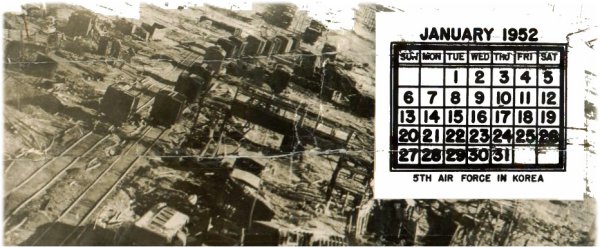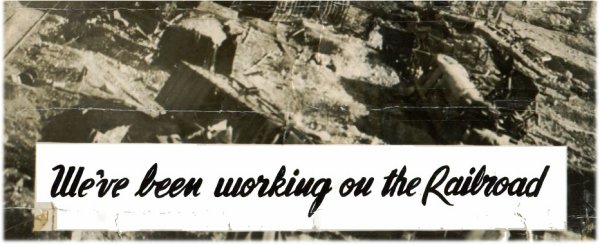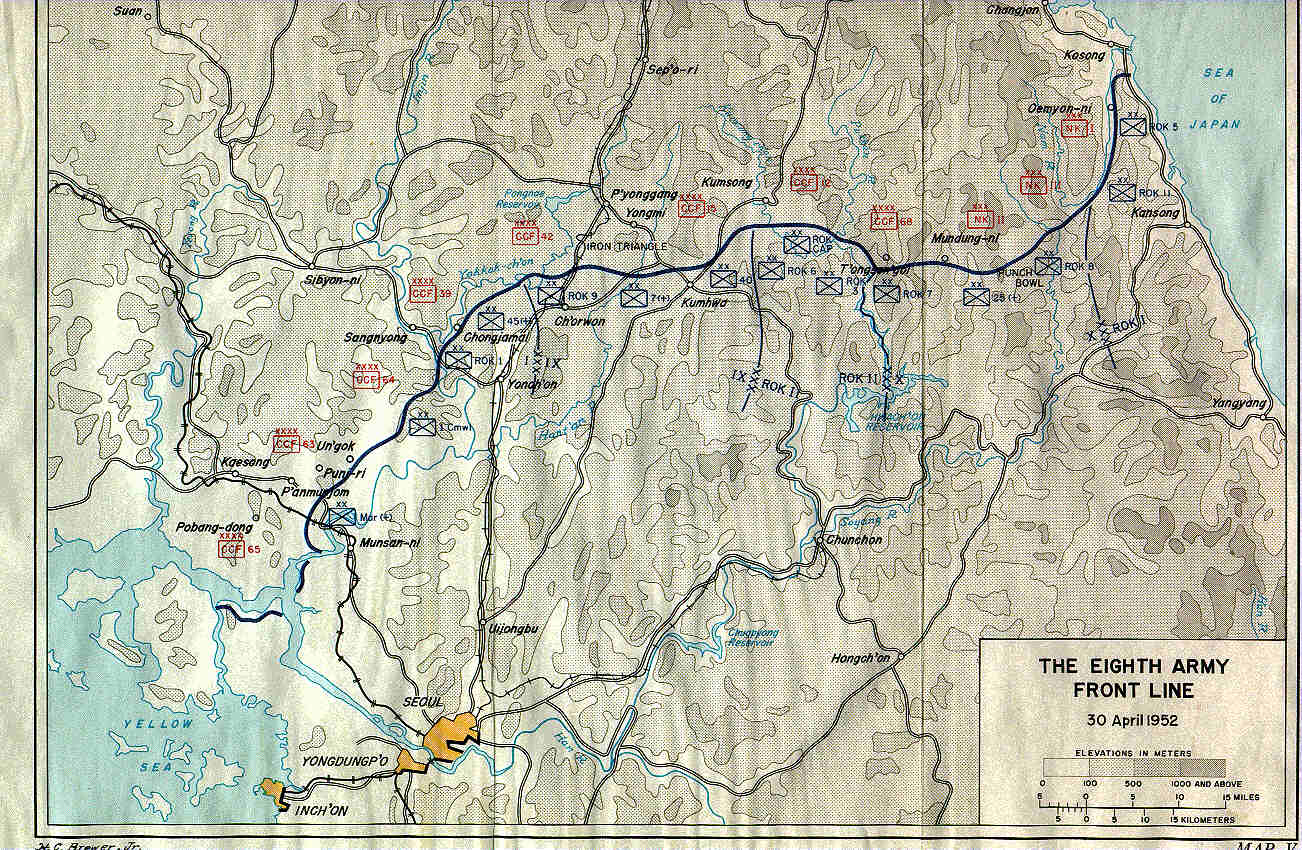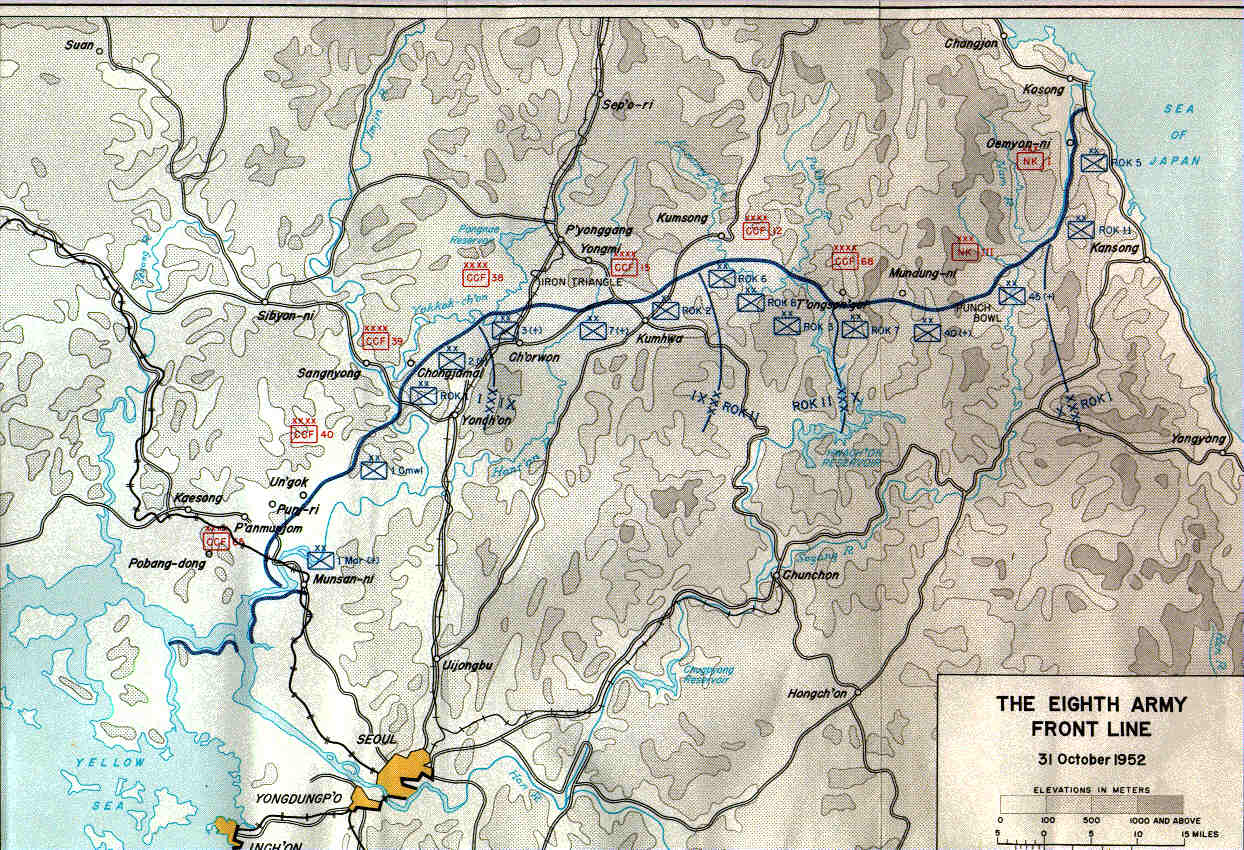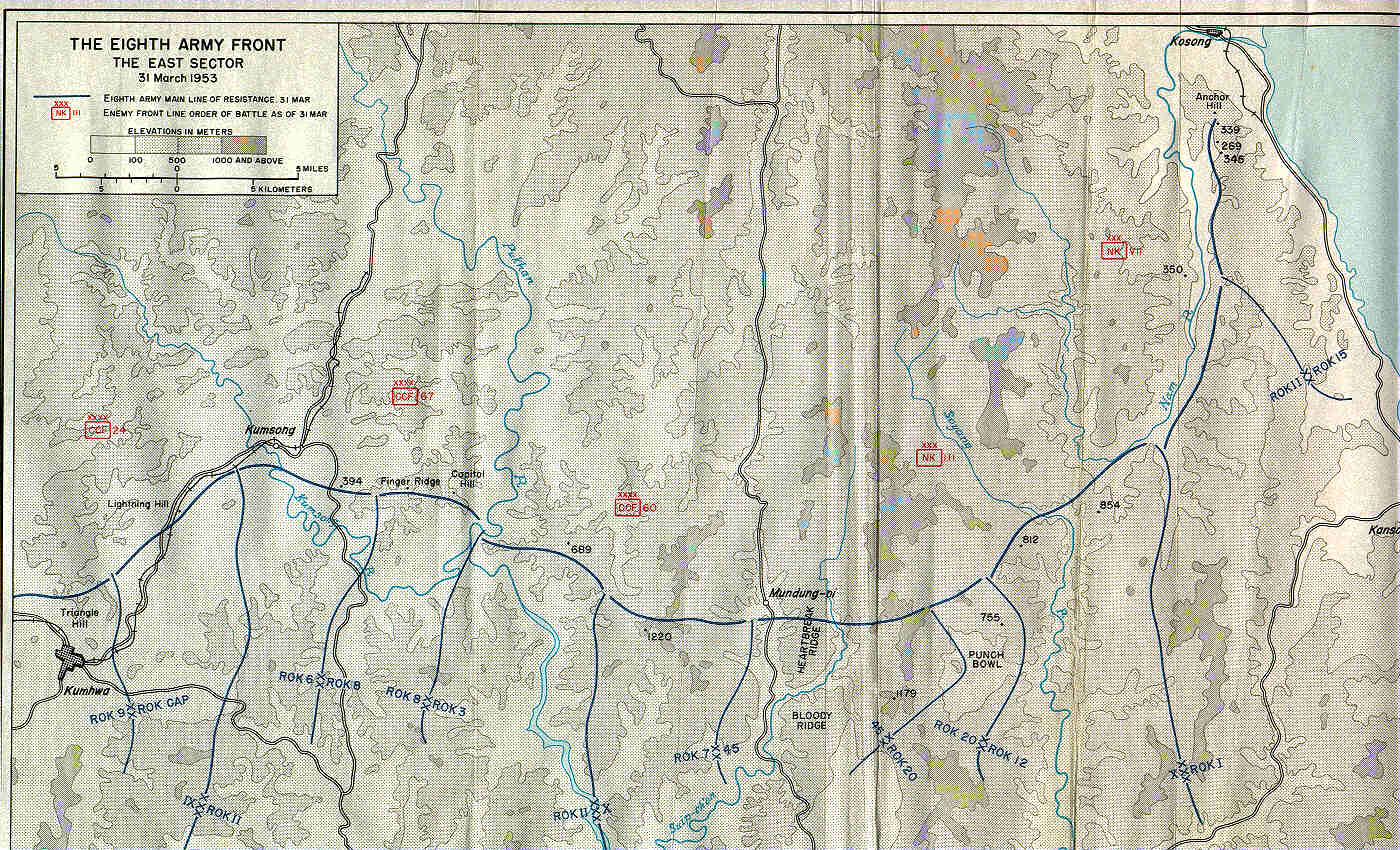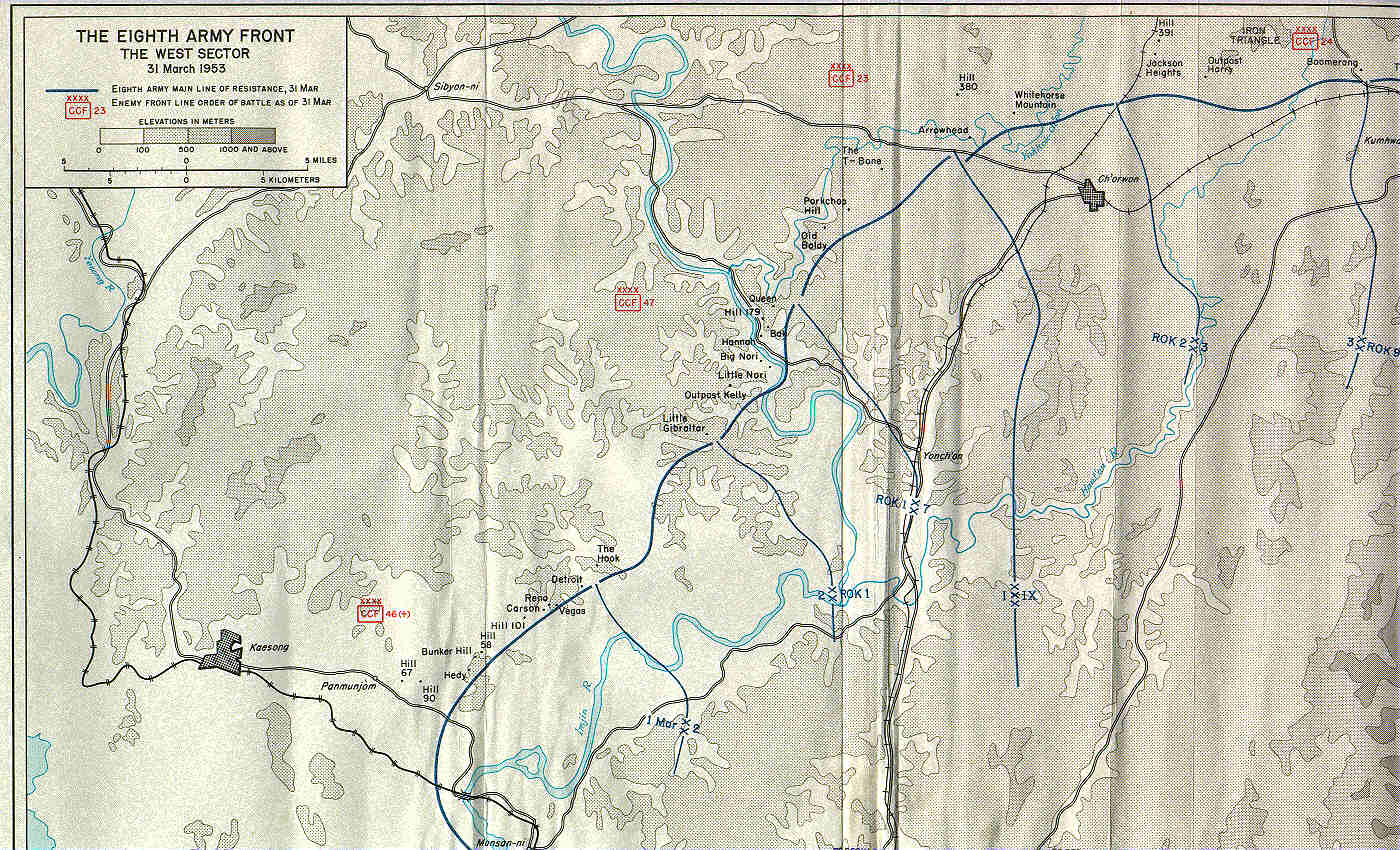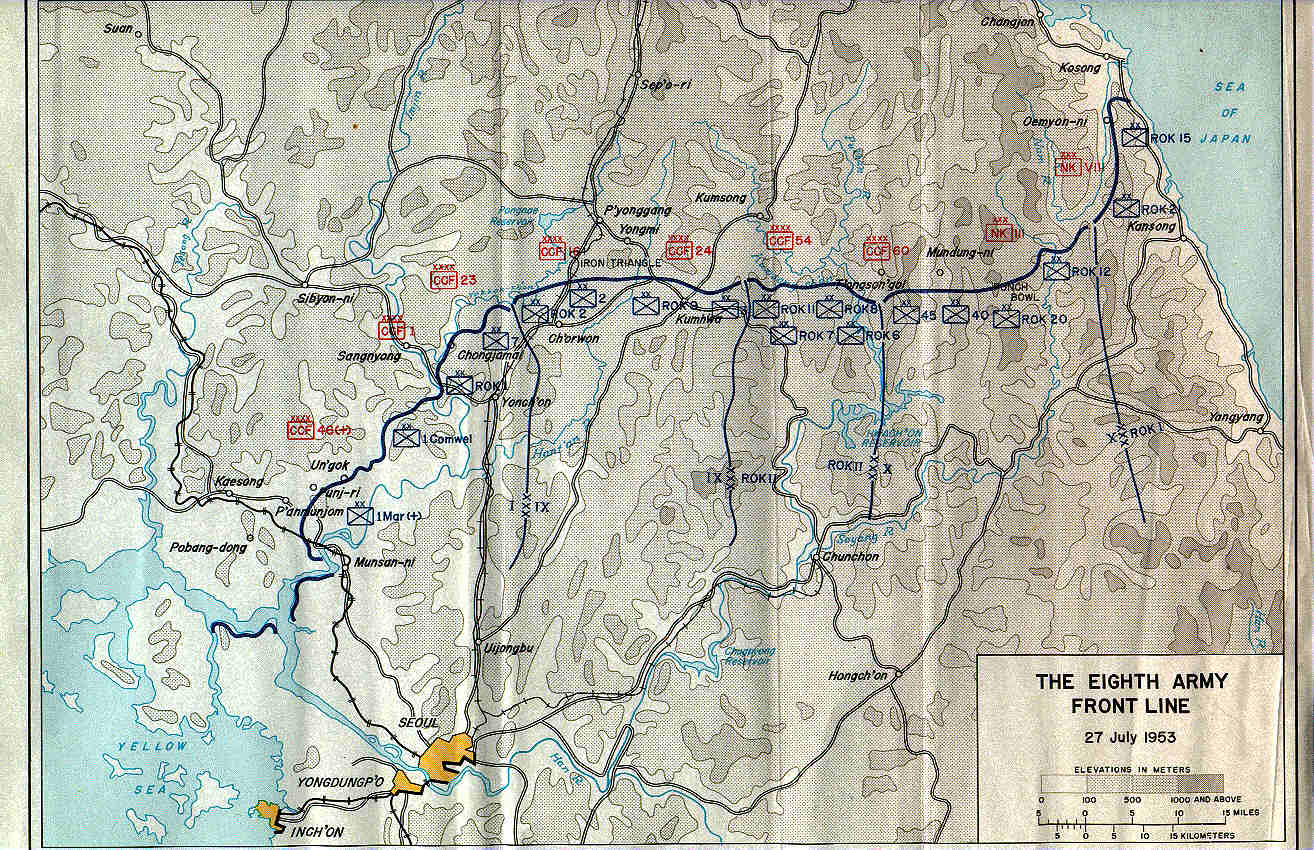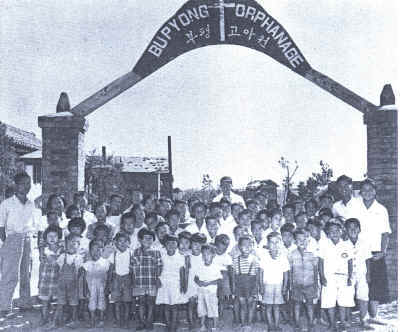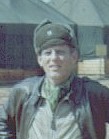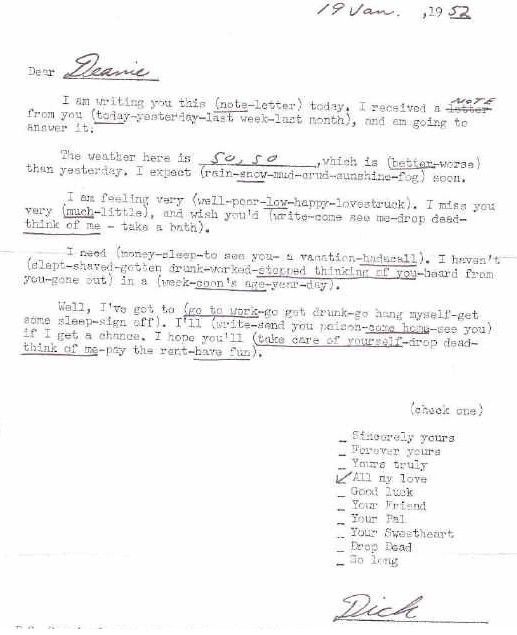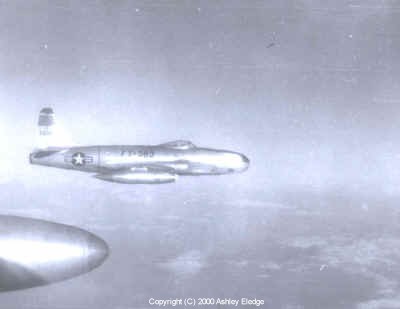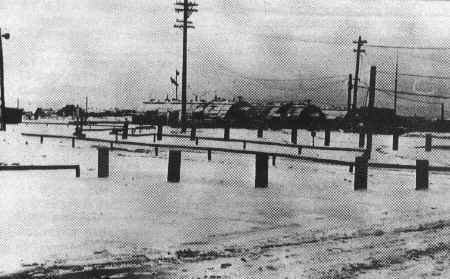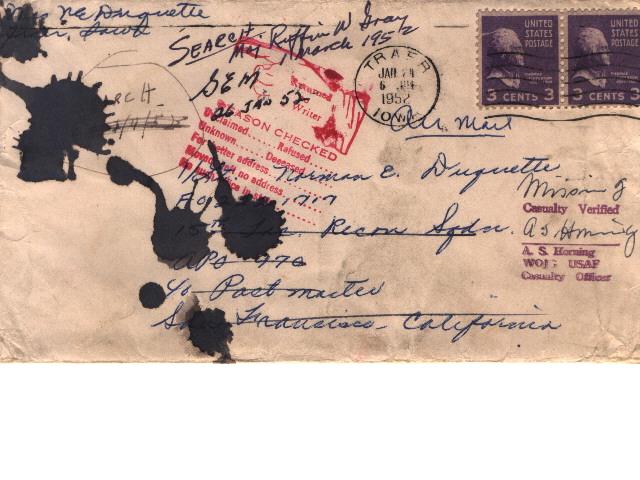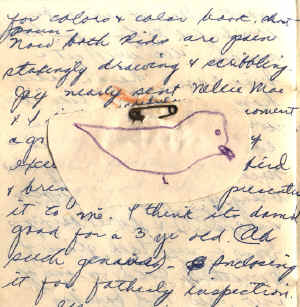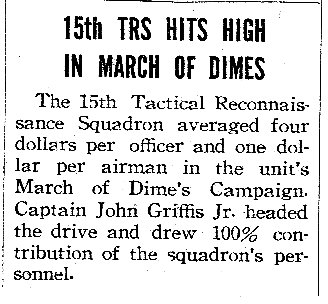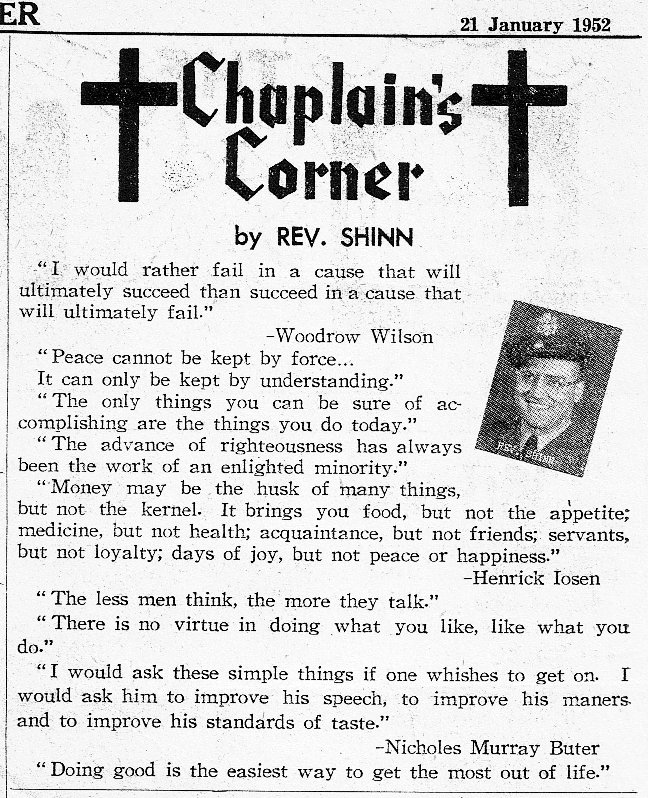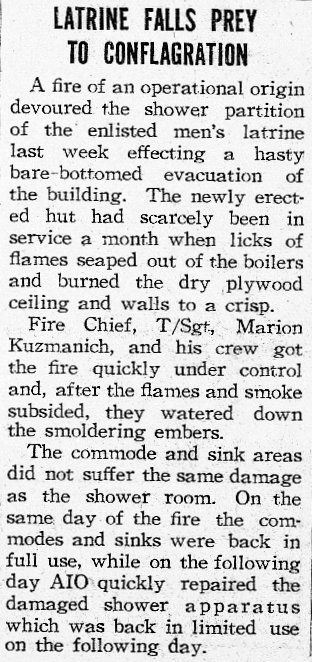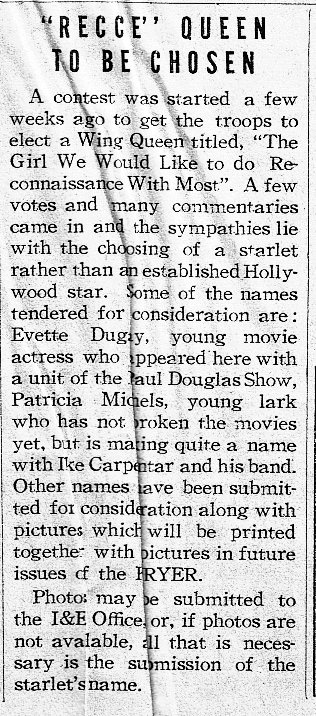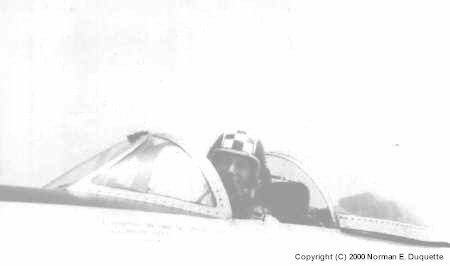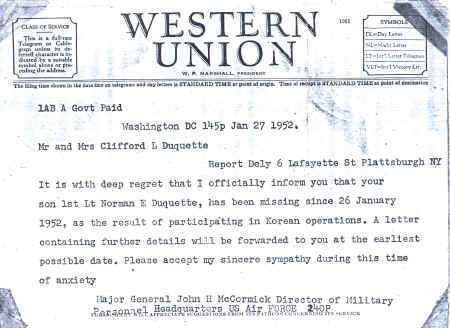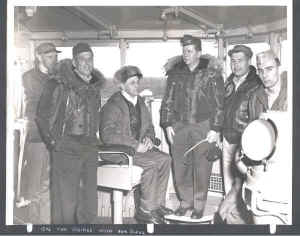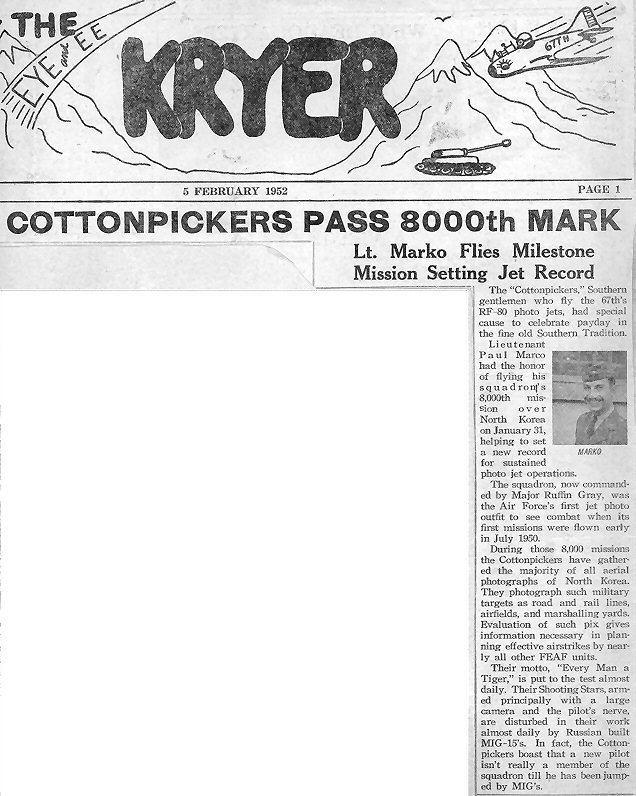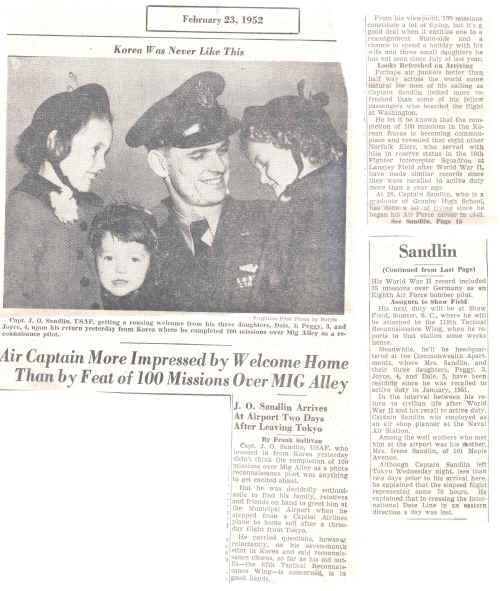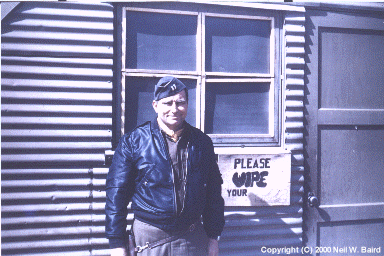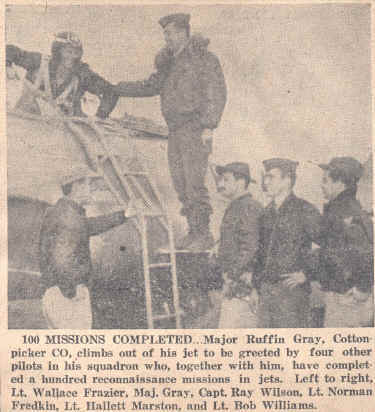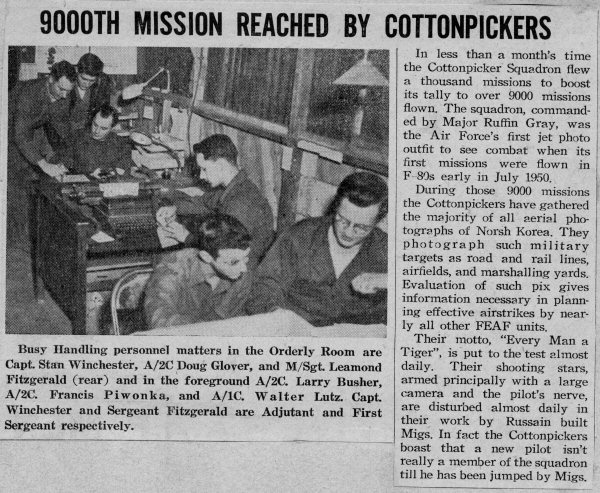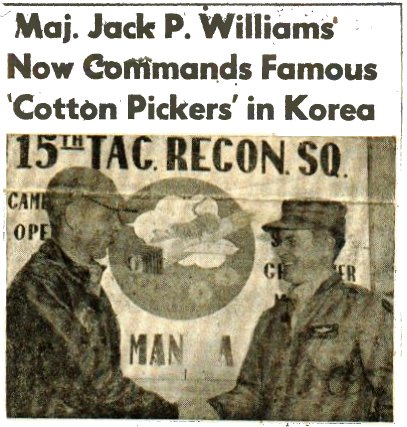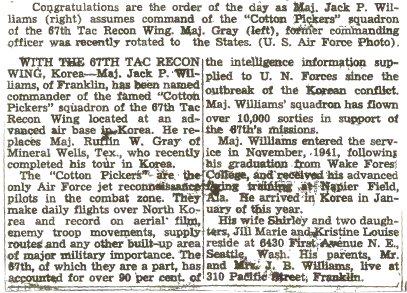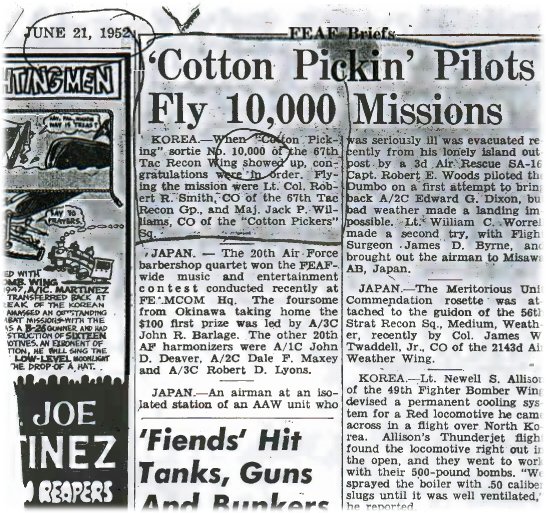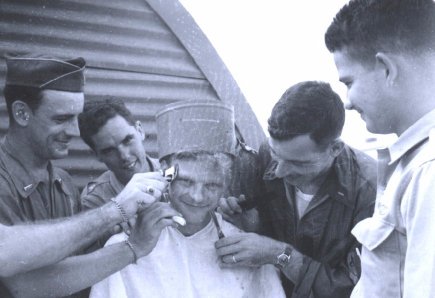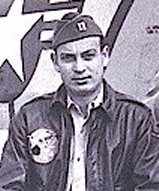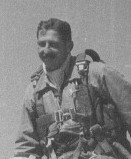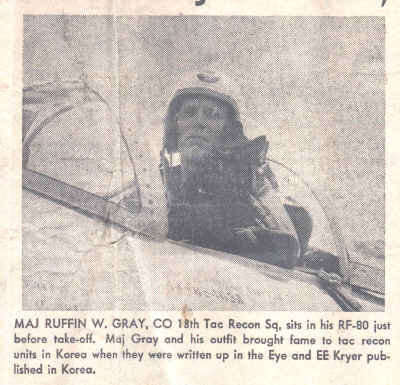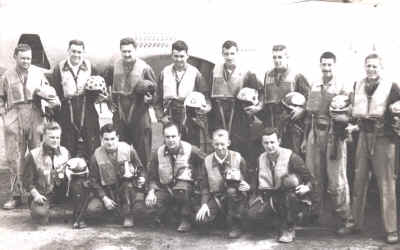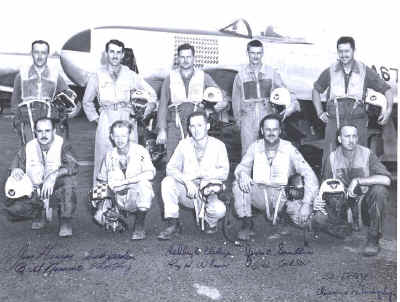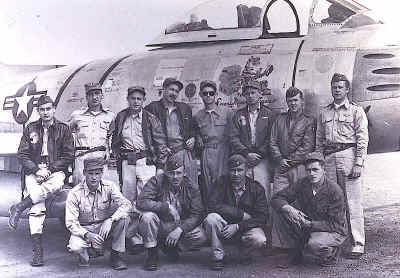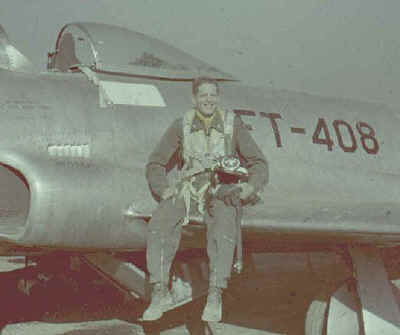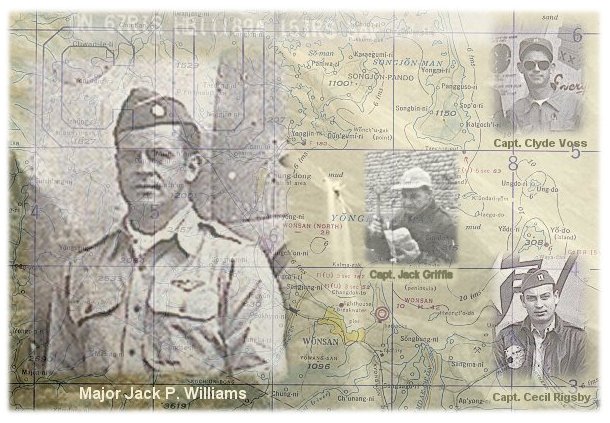
The Loss of
Major Jack P. Williams
Commander, 15th Tactical Reconnaissance Squadron
by John N. Duquette
On 23 June
1952, the air forces of the United Nations Command launched a five-day
operation against the North Korean hydroelectric system. At the end
of five days and nights of air strikes, the electrical generating
capacity of North Korea had been reduced by 90%. Lieutenant General
Glenn O. Barcus, Commander, 5th Air Force called the operation “a
singular success”. He noted to his superiors that only two Navy
aircraft had been lost in the entire operation and that air search
and rescue units had recovered the pilots of these planes. Not included
in these statistics was the loss of a U.S. Air Force RF-86A and its
pilot, Major Jack P. Williams, Commanding Officer, 15th Tactical Reconnaissance
Squadron. This is the story of that operation and the circumstances
relating to the loss of Major Williams.
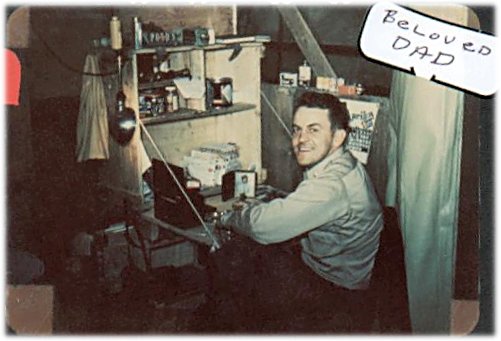
Major Jack Williams in his tent
Kimpo Airfield, Spring-Summer 1952
Spring 1952
Kimpo Airfield (K-14)
Republic of Korea
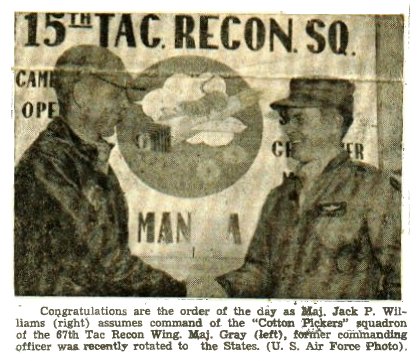
Maj. Ruff
Gray and Maj Jack Williams change command of the 15th TRSOn 16 April
1952, Major Ruffin W. Gray passed the command of the 15th Tactical
Reconnaissance Squadron (Photo Jet) to his tent mate Major Jack P.
Williams. Of the event Gray later wrote,
"I felt so keenly about the squadron that I absolutely refused
to relinquish command to just anyone; however, once I knew Jack, I
had no reluctance in turning it over to him--feeling, as I did it,
that the squadron would benefit by the change. What a wonderful leader
he was and what an outstanding example he set! The men and officers
all loved him." (1)
*****
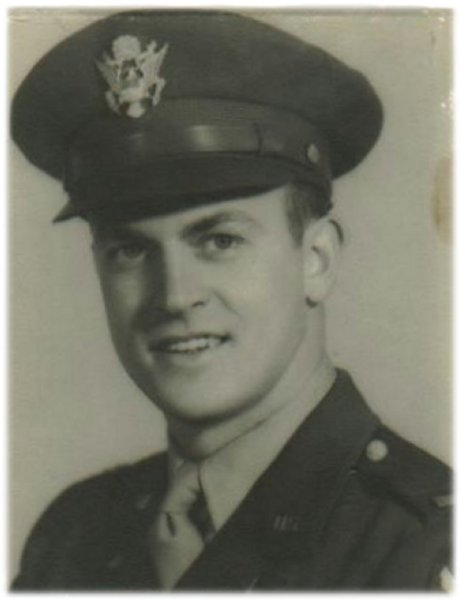
Lt. Jack Pryer
Williams, U.S. Army Air CorpsJack Pryer Williams enlisted in the Army
Air Corps in October 1941. He received his wings as a Second Lieutenant
on 3 June 1942. After serving as an instructor at Moody Field, Georgia;
Harding Field, Louisiana; and Henderson Field, Florida, Lieutenant
Williams was assigned to Adak in the Aleutian Islands in August, 1943.
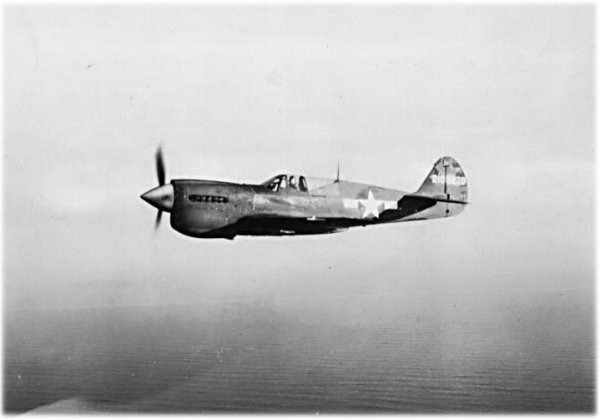
Lt. Jack Williams flying a P-40 "Tomahawk"Between the Second
World War and the Korean War, Williams' duty stations included Biggs
AFB, in El Paso, Texas, where he attended the Staff and Command School.
He was also stationed at Greenville AFB, South Carolina, and Langley
AFB, Virginia. In December 1951, he and his family were at his parents’
home on Christmas leave when he received word of his assignment to
Korea. He shipped out almost immediately and arrived at Kimpo Airfield
shortly just after New Year's 1952 where he was assigned to the 15th
Tactical Reconnaissance Squadron. (2)
Despite his
11 years of service, this was Williams' first assignment to a tactical
reconnaissance unit. As such, he spent his first days in Korea getting
oriented to the terrain, the aircraft, the camera configurations,
and the photo-reconnaissance techniques used by this unique squadron.
In a letter to his sister shortly after arriving in Korea, he captured
his initial impressions of the country and the reconnaissance mission
:
4 February
1952
Kimpo
Airdrome
Korea
Dear Wease,
Bill & Margie,
It has
been a bitter cold day today here at Kimpo (only time I really been
warm today was up flying this morning in an RF-80 [R for reconnaissance]
with a heater that really put out even though it must have been -40
degrees or so at 12,500 feet). We are located about 20 miles northwest
of Seoul, almost on the West Coast—not far from Inch’on
where, incidentally, you'd better watch out for our Navy shoots at
anything that flies overhead.
I am not
“operational” flying combat missions yet, but should be
soon. I have been flying practice photo missions and trying to learn
this recon business. We do visual and weather reconnaissance as well
as photo. The cameras (we can carry as many as five big ones in the
nose) are preset by our ground crews, so it's pretty much automatic
for the pilot. You have only five switches to work, plus flying the
plane, dodging Migs and flak. Seriously, however, most of the pilots’
concentration is required in getting his plane aligned with the target,
and flying at a constant airspeed and altitude while the cameras are
working…
…It's
been quite a mild winter in Korea thus far, so I’m told, &
it really hasn't been too bad since I've been here except for two
or three days. Korea is about the same size & shape as Florida,
but is rough and rocky like the territory west of Denver. The Koreans
are surprising people, and have intense national pride, despite the
fact that some nation has dominated them almost all their history.
They impress me more than the Japanese and have better farms, buildings
& factories. Hope this finds you all well and happy. Write me
when you can.
Love,
Jack (3)
*****
Williams'
first combat mission over North Korea came in early February 1952.
In late March, nearly a month and a half later, he took over as acting
commander of "The Cottonpickers" Squadron when Major Gray
received his assignment back to the States. After several weeks transition,
MAJ Gray departed and Williams became the commanding officer “on
his own” on April 16th.
On Sunday, June 15th, Williams wrote a letter home. In this letter,
he mentioned that he had been put in for "the oak leaves of the
lieutenant colonel’s rank which my job calls for". He noted
that his many administrative duties as squadron commander were very
time-consuming; “But I’m still trying to get in one mission
myself each day we’re flying.” (4) By
June 26th, 1952, Williams had flown 89 combat missions over North
Korea—all in RF-80 "Shooting Star" aircraft.
It was Air
Force policy that after flying 100 combat missions, pilots were rotated
back to the United States. By squadron tradition, the last ten of
these combat missions were “milk runs”—photo missions
that were the least dangerous of those needing to be flown. Williams
had one “sweat” and ten “no sweat” missions
to go. At his current rate of flying, he was expecting to be back
in the United States by the end of July.
May 1952
Headquarters,
CINCUNC
Tokyo, Japan
In May 1952,
the war was nearly two years old. The armistice talks at Panmunjom
were approaching the end of their first year without any hint of resolution.
On 12 May, General Mathew B. Ridgway passed the responsibilities of
the Commander in Chief, United Nations Command to General Mark Clark
and went to Europe to replace General Dwight D. Eisenhower as the
Commander of NATO. As the new commander in the Far East, Mark Clark
had his staff and subordinate commanders enumerate the options in
which he might be able to influence the Peace Talks through military
action.
The most
viable proposal came from General Otto P. Weyland; the new commander
of Far East Air Forces. Weyland proposed an all-out air attack on
the North Korean hydroelectric system. This system powered North Korean
industry that for the most part had gone underground to avoid UN air
attacks. A weakness of this proposal was in order to be decisive,
attacks had to be made against the largest power production plant
in the system--the Suiho hydroelectric plant on the Yalu River. This
strategic target had already received several reprieves since the
beginning of the war given its location on the border between China
and Korea. The possibility of UN aircraft mistakenly flying across
the border into Chinese airspace might provoke an escalation and expansion
of the war. In addition, the Suiho Dam provided approximately 10%
of the electrical power requirements of China's key industrial area
in Manchuria. Thus, striking Suiho would have a direct impact on China.
(5)
General Clark
directed that two sets of plans be prepared for attacks against the
hydroelectric system; one plan with Suiho as a target and one without.
These plans were then submitted the Joint Chiefs of Staff in Washington,
D.C. On 19 June 1952, the Joint Chiefs of Staff relayed to General
Clark that his plans to hit the North Korean hydroelectric plants--to
include the Suiho Dam--had been approved by President Truman.
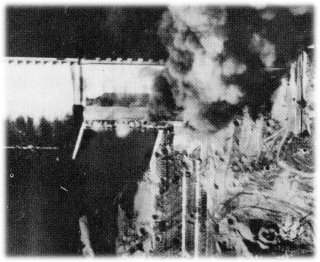
Suiho Hydroelectric Plant, 23 June 1952
In the afternoon
of 23 June, the air offensive began with the combined attacks of US
Navy, Marine and Air Force aircraft on the Suiho Dam and the Chosen,
Fusen, and Kyosen hydroelectric complexes. Follow-up attacks occurred
on the 24th, 26th and 27th of June. When the smoke cleared, the lights
had been turned out all over North Korea and would remain that way
for at least two weeks.
When news
of the attacks on the Suiho Dam had been announced in the press, the
British Government reacted immediately with indignation and concern.
They had not been informed that the attacks were about to take place,
and the massive air strike on the Suiho Dam heightened its concerns
that the Korean War could expand into mainland China. British Parliament
demanded an explanation.
By coincidence,
U.S. Secretary of State Dean Acheson was in London when the storm
over the bombings had reached its peak. On the morning of 26 June,
Acheson addressed a group of members from both Houses of Parliament:
"Now
you ask me whether this was a proper action. To that I say: Yes, a
very proper action, an essential action. It was taken on military
grounds. It was to bomb five plants, four of which were far removed
from the frontier, one of which was on the frontier. We had not bombed
these plants before because they had been dismantled, and we wished
to preserve them in the event of unification of Korea. They had been
put into operation once more; they were supplying most of the energy
which was used not only by airfields which were operating against
us but by radar which was directing fighters against our planes.
My hearers
seemed to approve. They applauded heartily when in reply to a question
I said that the attack had been highly successful. Nevertheless, when
I met privately with Eden, he pleaded for “no more surprises.”
(6)
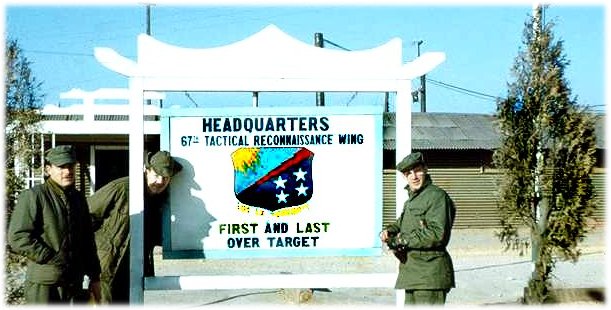
1800 Hours,
26 June 1952
67th Group Operations
Kimpo Airfield,
Republic of Korea
As Acheson
dealt with the uneasy Britons on the other side of the world, it was
evening in Korea. At Kimpo, operations and intelligence personnel
of the 67th Tactical Reconnaissance Group Ops began to compile the
list of recce missions that would be flown the next day -- June 27th.
It is the
nature of things that all air operations start and end with Tac Recce.
As such, the 67th Group Ops played a vital role in the air war over
Korea. There were "routine missions" to assign to each of
the three squadrons in the group -- like the daily early morning run
over North Korea to gauge the weather, the weekly photography of the
enemy's front lines, and the periodic reconnaissance of bridges, rail
lines, and airfields to monitor the status of Communist repair efforts.
There were pre-strike missions to take target photography that would
be used by pilots and bombardiers in the medium, light, and fighter-bomber
squadrons to plan their attacks. And then there were the battle damage
assessment or "BDA" missions. After the air strikes went
in, Tac Recce pilots would return to photograph targets to see if
the bombers had accomplished their missions. With over 75 reconnaissance
aircraft in the group flying 100 to 150 sorties to per day, it took
quite an effort by the Groups Ops personnel to pull it all together.
By midnight, the target lists had been dispatched to the 12th, 15th
and 45th Squadrons.
*****
0400 Hours,
27 June 1952
15th TRS Operations,
Kimpo Airfield, ROK
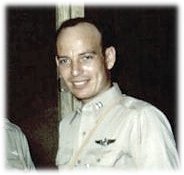
Captain Cecil
Rigsby In June 1952, the squadron operations officer for the 15th
was Capt. Cecil R. Rigsby. Rigsby was an old hand at photo recon.
As a photo reconnaissance pilot during World War II, he had served
in the Pacific with the 8th Photo Reconnaissance Squadron in New Guinea.
Between November 1942 and April 1944, he flew 91 combat missions in
F-4 and F-5 reconnaissance aircraft. "About 10 of these missions
were fighter escort missions in the P-38H fighter", he remembered.
After the
war, Rigsby left the Army Air Corps to pursue civilian life as--a
photo recce pilot. Between 1946 and 1948, he was the chief pilot for
the Kargl Aerial Survey Company of Midland, Texas. He flew F-5s, AT-21s
and a BT-14 surplus WW2 aircraft--all had been converted to allow
for aerial photographic mapping. He photographed nearly all of West
Texas, New Mexico and much of Colorado for the USGS and Oil Companies.
He recalled later,
"When I left [the service], I was in the 39th Tactical Reconnaissance
Squadron--the fourth squadron of the 410th Fighter Wing--at March
Field, California. The Cold War heated up so the 67th Recce Group
was formed and the 39th Squadron was redesignated the 12th TRS.
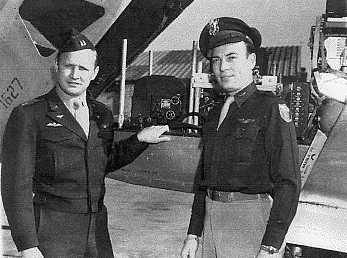
Capt.
Clyde East and Lt. Cecil Grigsby, 1948I received a letter one day
in late 1947 asking me if I wanted to come back on active duty. If
I volunteered to come back on active duty I had to go back to 1st
Lt. and that is what happened. I went back into the 12th TRS, the
same one I was in before and found the squadron full of fighter pilots
who wanted to fly jets. Captain Clyde East was the Intelligence Officer
and I was assigned as his assistant. Between the two of us we flew
most of the aerial photography while the fighter pilots flew in formation
and engaged in aerial dogfights.
I arrived
in Korea in February 1952. I flew my first combat mission on 1 April
1952..."
Since the
first strike against the North Korean hydroelectric system on 23 June,
"The Cottonpickers" had been involved in BDA photography
for this air offensive. As squadron operations officer, Capt. Rigsby
planned the first BDA mission for the Suiho Dam strike. This recce
mission followed right on the heels of the Navy and Air Force fighter-bombers.
Escorted by 16 F-86 Sabre Jets, two pilots from the 15th flew their
RF-80s north to the Yalu and then paralleled the river to the northeast
towards the Suiho Reservoir. Deep inside Mig Alley, they began their
photo runs no less than 20 miles from the Chinese fighter base at
Antung. The Chinese and North Koreans had been surprised by the fighter-bombers,
but the gloves were off an hour later when the two "Cottonpickers"
made their runs in. Several antiaircraft batteries hammered away from
both sides of the Yalu as the RF-80s streaked in towards the huge
column of smoke and flame billowing from the Suiho power house. The
15th pilots got their photos, climbed to altitude, and returned to
base just as the sun began to set. The Russian and Chinese MiG-15s
at Antung never left the ground. The Tac Recce slogan, "First
and Last over the Target..." was no idle boast that day--from
either side of the Yalu. (6)
*****
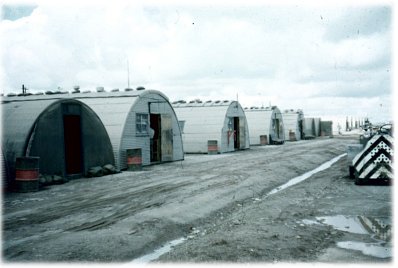
"First
and last in squadron operations...", might be an appropriate
way of describing Capt. Rigsby's five and a half months in Korea.
The sun rose over Kimpo Airfield at 5:11 a.m. on 27 June, but he and
the squadron intelligence officer, 1st Lt. Keith E. Brown, were up
and at work long before that:
"We had a very big squadron with nearly twice the airplanes
and twice the pilots of a normal squadron. To fly as many as 50-combat
missions or more per day required nearly everyone who had a secondary
or primary job to work like hell. When you read about pilots going
into town, having fun off the base or hanging out each night at the
Cottonpickers, that life style didn't apply to those of us in Operations
and Intelligence and probably some other sections.
The Intelligence
officer and I would get up early in the morning and with help from
the noncoms, [we would] plot all the targets on a big map board in
grease pencil. At this point we would divide them up into missions.
We would all try to go to the Group Intelligence, Army Liaison, and
the Weather briefing each morning and then meet in Operations. The
pilots could look at the board and see where they stood in rotation
and would not leave until it was obvious they had a few hours before
being called upon.
We also
had missions coming to us from 5th Air Force during the day. I don't
believe I was in the Orderly Room or the Group Commander's Office
more than a couple of times during my entire tour. That is how busy
we were flying the missions and getting them off the ground. I'm glad
that I was only age 29 and able to work with not much sleep..."
In the 15th
Ops Hut, Capt. Rigsby and Lt. Brown reviewed the list of targets from
67th Group Ops. As they sketched out the scheme for accomplishing
the day's assigned recce tasks, Rigsby recognized one of the targets
on the list--Chosen Hydroelectric Plant #3. He was familiar with this
particular target; he had flown an RF-86 'dicing' mission against
it the previous day.
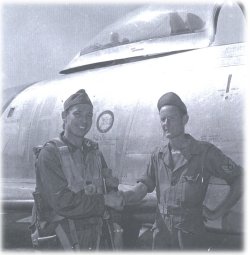
Capt.
Cecil Rigsby and Crew Chief - Kimpo 1952
The Chosen
Hydroelectric Plant #3 was located about half way between the North
Korean port city of Hungnam and the Chosen Reservoir. One of four
hydroelectric plants in the Chosen power system, Chosen #3 had been
hit by the 1st Marine Air Group on June 23rd. Air Force fighter-bombers
hit it again on the 26th. Rigsby flew his dicing mission after this
second strike. He was on his low-level photo run when he began to
receive fire from a heavy machine gun. I drew ground fire from a single
50-caliber machine gun firing tracer ammunition. The gun was along
the line of flight and tracers went above me and below the aircraft.
I held the heading and descending altitude long enough to ensure I
had good coverage". Rigsby got his pictures and returned to Kimpo
unscathed.
Today--according
to the target list he held in his hands?the 15th would be going back
to Chosen #3. Rigsby assigned aircraft and pilots to targets and discussed
the set up with Major Williams when he arrived at operations.
"I had the names of all pilots present for flight duty on a board
with little hooks so I could move them around. To insure that all
pilots fly their missions in rotation, I would give the next mission
up to the next pilot up if I thought he was experienced enough to
handle it. However, we may have had as many as 10 or more missions
to fly within a couple hours of each other. In this case I could be
selective. Also, we had to decide whether or not to assign an RF-80
or an RF-86. If the mission was more dangerous than others and the
RF-86 could do the job, we assigned the RF-86. I believe Jack Williams
was flying his missions in rotation, but as I recall he wanted this
mission."
Normally,
reconnaissance flights into the northeastern part of North Korea were
single aircraft recce missions. However, because of the antiaircraft
fire Rigsby received over Chosen #3 the day before, it was decided
that Williams should have an armed escort to suppress any enemy air
defenses in the target area. The next pilot "up" was Capt.
Clyde Voss.
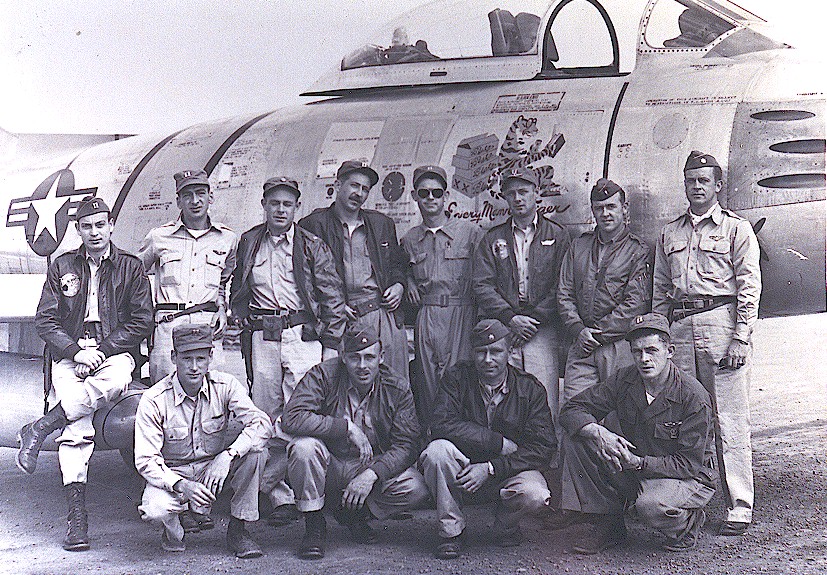
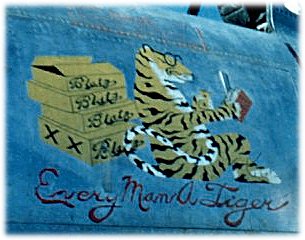
RF-86
FU-217 "Every Man a Tiger"
RF-86 Pilots of the 15th TRS pose in front of the aircraft in which
Major Williams was shot down. Major Jack Williams is standing at far
right. Captain Clyde Voss is standing fifth from the left (wearing
sunglasses). Capt. Cecil Rigsby is on the far left sitting on the
fuel tank. Photo taken in May-June 1952 timeframe.
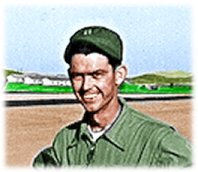
Born in Texas,
Captain Clyde K. Voss attended Texas A&M before the start of WWII.
In December 1941, Voss was in his third year in college when the Japanese
attacked Pearl Harbor. He signed up for pilot training in the U.S.
Army Air Corps. Earning his pilot's wings, he was assigned to the
364th Fighter Group in England. He flew P-38 and P-51 fighters over
occupied Europe, and was credited with shooting down three German
aircraft. In September 1944, while flying his 68th combat mission,
he was shot down behind German lines. He managed to evade capture
with help of the Dutch underground.
When the Second
World War ended, Voss was assigned as a Fighter Gunnery Instructor
at Foster Field, Texas. In March 1946, he was transferred to the 1st
Fighter Group at March Field, Calif. Here he began flying the first
P-80 Jet fighters to enter service. In 1948, he was sent to the Pacific
where he was assigned to the 51st Fighter Group at Naha Air Base,
Okinawa. He continued to fly P-80s with the 51st Fighter Group until
1950. By June 1952, he was a veteran jet-fighter and photo reconnaissance
pilot and the commander of "B" Flight, 15th TRS. He was
also the squadron's Test Pilot and Instructor Pilot (IP) for the RF-86.
When Voss
arrived at operations, he was informed he would be flying that morning
with the squadron commander. Capt. Rigsby then briefed Williams and
Voss on their mission. It was a dicing mission consisting of two RF-86s.
Take off time would be 0915 hours. Williams would fly FU-217 and take
the photos; Voss would have hot guns and would suppress any antiaircraft
fire they received on the run in. Rigsby recalled,
"I briefed Jack Williams on the altitude to approach the
target, aiming of the aircraft, intervalometer setting and the ground
fire I had encountered the day before. This is the reason we sent
two airplanes. To get good photos at very low altitude with the 40"
focal length camera it was necessary to slow the RF-86 to avoid motion
in the lower 1/3 of the picture. The lens speed of this camera would
not compensate for high-speed low altitude passes. In all the missions
I flew with this camera I had to come in slow over the target. The
40" focal length camera did permit you to break off the target
before passing over it, or you were in your break when the airplane
went over the target. I also told him about the motion problem with
a high speed pass and that he should consider a slower approach, but
it was up to him.
Williams and
Voss discussed how they would approach the target and what they would
do if they received any ground fire. "It had been assumed that
if we were fired upon during the pass through the valley, I would
be the first to know. The idea was that if we drew fire and could
see the source, I would turn in on it and suppress it, " Voss
remembered. At around 0830, he and Williams had completed their flight
plan and went to the personal equipment hut to get suited up in their
flight gear. This completed, they walked to the flight line, pre-flighted
their aircraft and taxied for takeoff.
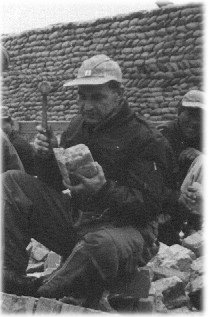
Capt. Jack
W. GriffisAt least two other 15th pilots were slated for missions
that morning; both were scheduled for take off less than an hour after
Williams and Voss. Capt. Rigsby was scheduled to take mosaic photography
of the enemy's frontline positions in an RF-80. Capt. John ("Jack")
W. Griffis, Jr. was scheduled to fly but his planned flight for that
day is lost to memory. We can be certain it looked nothing like the
mission he would actually fly. As the commander of "C" Flight,
15th Tac Recon Squadron, Jack Griffis' call sign was "Charlie
One".
At 0915, Maj.
Williams and Capt. Voss were airborne and headed northeast. They climbed
to an altitude of 25,000 feet and proceeded across the peninsula towards
Hamhung; Voss was behind and to the left of Williams’ aircraft.
They soon crossed the bomb line and Williams reported this to the
Joint Operations Center (JOC).
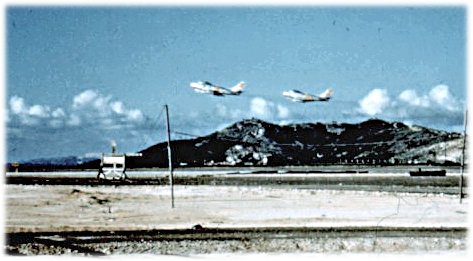
After about
15 minutes, the pair of RF-86s was in the vicinity of Wonsan. Williams
began to descend into the target area. As planned, Voss fell to the
rear of Williams to get into his trailing, over watch position. Voss
remembered, “We descended toward the mountain pass from 25,000
feet. We reached the correct altitude to fly through. I was directly
behind and a little higher than Jack to be where I would better be
able to see if he came under fire. I was looking down at the target
area while maintaining position and watching him.”
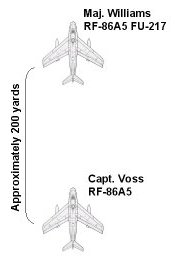
At about five
miles out from the Chosen hydroelectric plant, they had descended
to about 3000 feet and were flying 100 knots slower than the planned
approach speed. “We were flying at about 275 knots. I urged
him to speed it up. He just once said, 'In a minute'. He sounded wide-awake”,
Voss recalled.
Thirty to
45 seconds out from the target they were still flying too high and
to slow; something was wrong. Voss called Williams but got no response.
Unknown to Voss, Williams had already spoken his last words.
“We had flown over the target hydroelectric facility without
getting down to the low altitude we planned. Williams’ plane
began to stream what appeared to be fuel from the wing root trailing
edges." Voss hadn't seen any muzzle flashes, tracers, or any
indication of weapons firing from the ground, nor had he witnessed
any rounds strike his aircraft. Nonetheless, William's was streaming
fuel. "I called Jack and told him he must have been hit and suggested
he turn left [south] and start for home. There was no answer from
him from that moment on, and no indications that any control inputs
[to his aircraft] were made.”
****
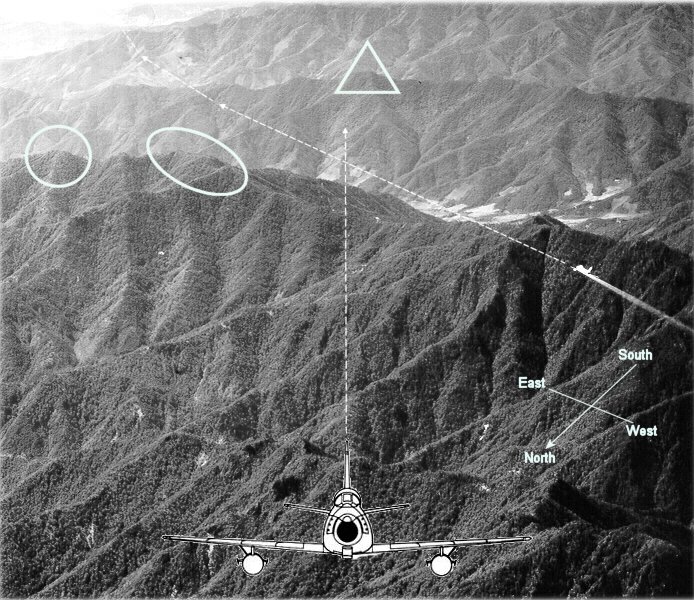
Frame
4: Fuel Streaming from Major Williams' RF-86A
t this point
occurred one of the most extraordinary incidents in the history of
the air war in Korea—Capt. Voss turned on his forward oblique
camera and started recording the events as they unfolded. Voss recalled,
“I began taking pictures with my foreword oblique camera when
I saw that he was losing fuel. I operated the camera manually when
I actually had something to photograph. His airplane began a gradual
climb and gentle turn away from home. His speed changed very little
from that time on except for the normal slowing [that would occur]
as the airplane began its very gentle climb--and very slight turn
to the right [north]. We passed over the mountains that formed the
northern part of the valley the river flowed through, and his airplane
continued to turn until it was heading east, climbing gradually.”
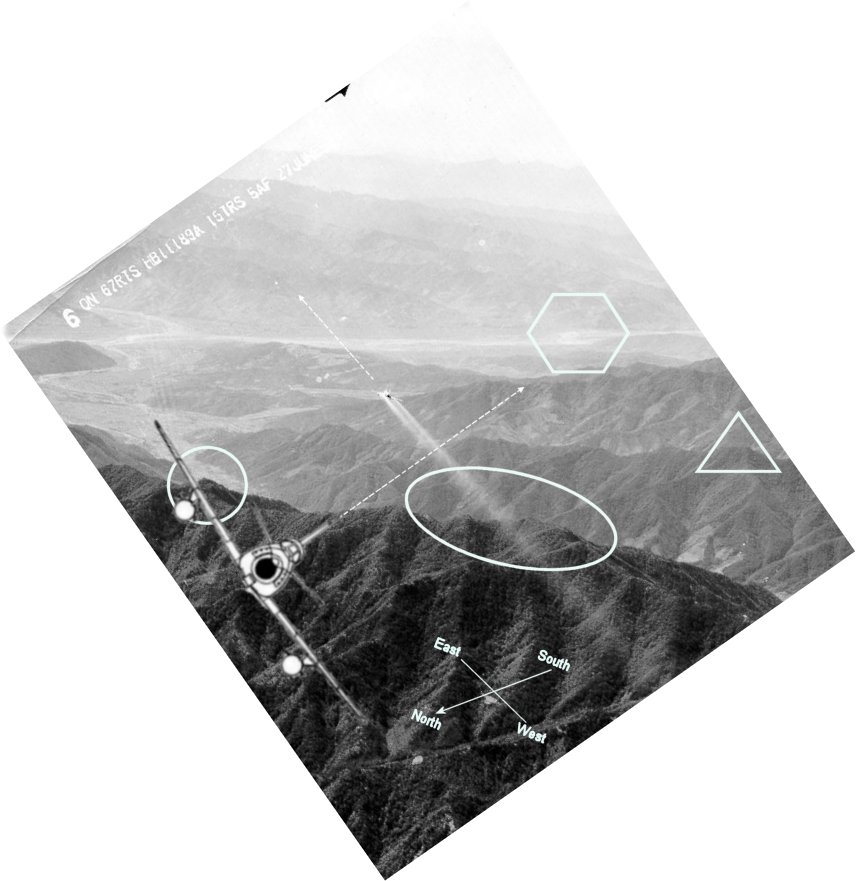
Frame
6: Capt. Voss maneuvers to Williams right side
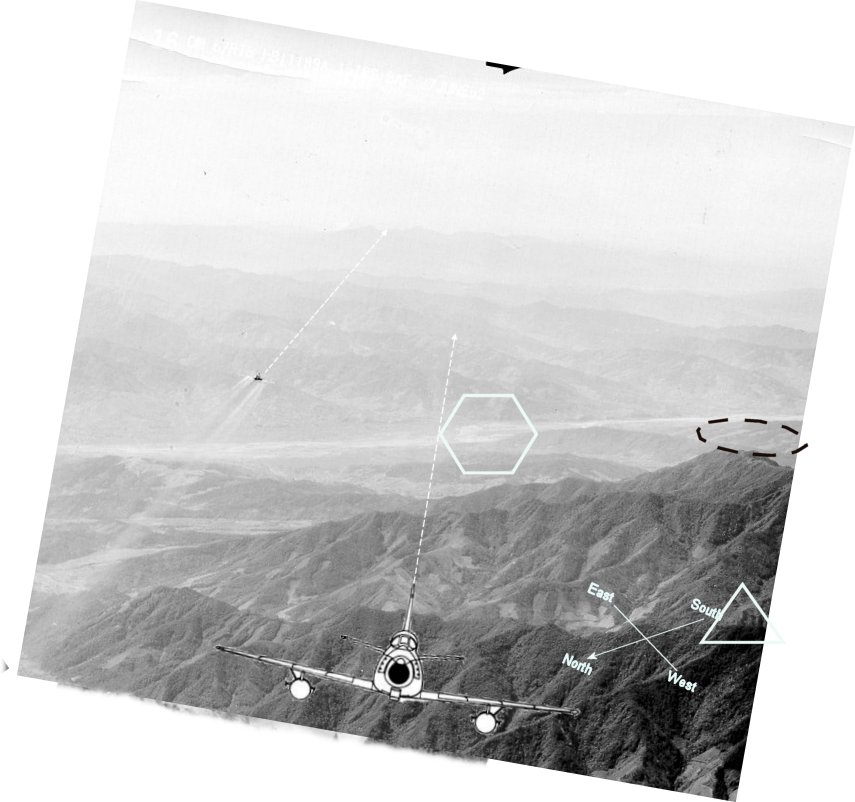
Frame
16: Capt. Voss closes on Williams' right side
Voss maneuvered
his aircraft from a position at Williams’ left rear to close
to his right wing. He hoped to get in close enough to see what was
going on in Williams' cockpit.
I couldn't see in the cockpit it was so full of smoke. Fire was
coming out of the fuselage behind the cockpit. I kept calling him
and telling him to bail out. From the time I first saw the fuel streaming
out around his wing roots, I couldn't raise him on the radio. At this
point the plane rolled to the right and into me rather abruptly. I
pushed over hard to avoid a collision as he passed over me and continued
rolling. [This] caused him to get behind me. The last I saw him, his
canopy was still on. I maneuvered hard to regain sight of him..."
and when I next saw him, his chute was deployed. I finally turned
enough to get the scene in my windscreen and took a few pictures.”
As Voss maneuvered
his RF-86 in a high-rate turn to the right, he caught sight of Williams'
plane below him as it impacted into the ground in a huge fireball.
Then, an encouraging sight--a deployed parachute descending to the
ground a hundred yards or so from the burning wreckage.
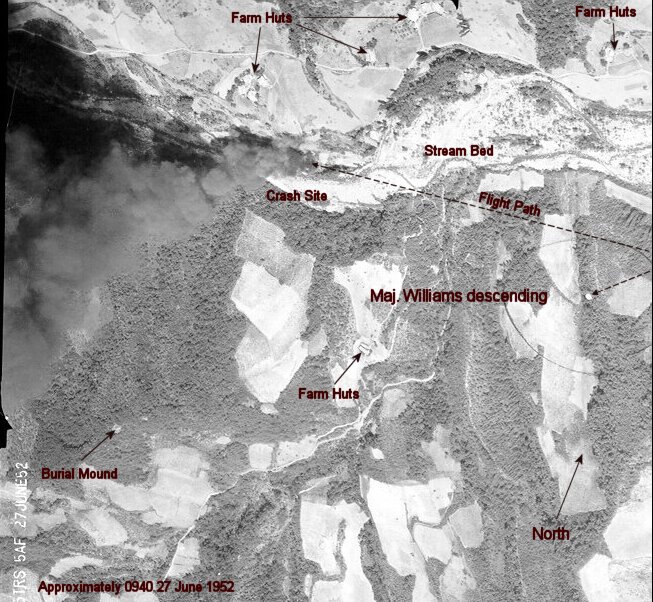
"After
the airplane crashed and the chute was on the ground, I made calls
for rescue and dived down around the scene. It was obvious that Jack
was not moving about though I could not see enough to tell what his
condition was. I was operating at very low-power to conserve fuel
so I was neither very low nor very fast. It is safe to say that I
was under 1,000 feet above ground level.
On one
of my runs past the crash site, I saw some local farmers who were
moving toward the chute. I strafed the ground a couple of hundred
yards in front of them. I had mixed feelings about whether he would
be better off if the local farmers could get to him or if we kept
them away. On the strafing run, I was not aiming at anything. I was
just spraying some rounds between the Koreans and Jack’s burning
aircraft. I didn't want to hit any of them; I just wanted to say,
“Stay back....”
After each
low-level run past the crash site, Voss climbed back to altitude to
continue his calls for assistance.
"Mainly
I needed to be above the mountains to make radio contact with someone
to help. I was short on fuel and trying to stay low enough to keep
Jack in sight on the ground. I knew I had only a limited time to CAP
[Combat Air Patrol]. I made a blind call on the Guard channel for
anyone at high-altitude to relay my call for anyone with sufficient
endurance to [replace me and] serve as a CAP.”
Approximately
0945 27 June 1952
15th TRS Operations Hut
Kimpo Airfield (K-14)
Griffis:
“I
was in operations when the word came in. It was a call from Clyde
and the location [of the crash site]. For some reason I had my gear
and was ready to fly. I must have had maps with me because someone
said where the mission had been. I knew exactly where to go. I vaguely
recall having been briefed on the hydroelectric plants and that I
had the locations on my maps. I went directly to the 45th Tac Recon
Squadron [flight line]. We went to the nearest F-80 that had people
near it. I seem to recall getting out of a vehicle so someone must
have driven me there. I told them that our squadron commander was
down and needed a CAP. I asked them if they had an F-80 ready to go.
They pointed me to the nearest one and someone said it was ready to
go with hot guns. I got in and took off. I didn't ask anyone's permission.
I think I was on the runway in 10 minutes or less after the word had
come in. [Once airborne] I went full bore to the scene...”
****

U.S.S.
Iowa off Wonsan, April 1952
The Battleship U.S.S. Iowa off Wonsan, North Korea - April 1952
It is probable that the HOS-1 helicopter at the stern is the aircraft
that picked up Major Williams.
Approximately
0945 27 June 1952
U.S.S. Iowa
Task Force 95 (Blockade and Escort Force - Rear Admiral J. E. Gingrich)
Sea of Japan
[U.S.S. Iowa
receives/monitors request for search and rescue and dispatches helicopter...Strong
possibility the aircrew of this helicopter was Navy LT Robert L. Dolton
and AM1 Willis A. Meyers. Dolton and Meyers had rescued LT(JG) Harold
A. Riedl on 16 July 1952 after his F4U was shot down 30 miles northwest
of Hungnam. This rescue occurred eleven days prior to Major Williams
being shot down.]
****
Voss:
“After
several attempts I got a reply from some Marines who said they were
in the area in Corsairs and could be there in 10 or 15 minutes. We
met at an agreed altitude and I led them to the site. With all the
smoke it was easy to find. Once I pulled up above the mountain to
start home, I heard the Marines talking as they approached the site
and it was a thrill to hear how gung ho they were to do the job. My
thought was that with those guys circling Jack, no one other than
the rescue people would be allowed to get within a mile of him.
The helicopter
was in contact with the fellow at altitude to relay my distress calls
and while they were on their way, they asked if the downed airman
was alive. That was relayed to me by the high CAP pilot. Of course
I answered ‘Yes’, because I didn't know what his condition
was. I only knew that he was on the ground and not moving. Chances
are good, I thought, that he was unconscious or disabled, but alive.
With that report the helicopter crew came on in.”
Griffis:
“When
I arrived at the site, there was a single Corsair circling in the
valley [and] I checked in with him. Something was said on the radio
about someone chasing a couple farmers away from the chute. I had
to make my passes down the valley as I could not turn between the
hills. Williams was lying on the corner of the chute in an open area.
I made a couple of passes down the valley before I noticed the chopper.”
U.S. Navy
HO3S1 HelicopterUsing the smoke from the burning remains of FU-217,
the helicopter crew was talked in to Williams’ location. “The
rescue chopper arrived and hovered off to the side and above the chute”,
Griffis recalled. They hovered over his location to get a good look
at him; the downdraft of the rotor blades buffeting the grass and
Williams’ parachute. After a moment, the helicopter pilot reported,
“He looks dead."
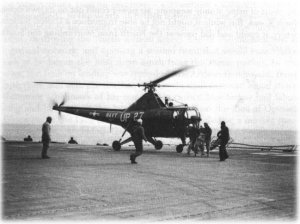
[last Voss
photo]
Griffis, orbiting
overhead, heard the call. He toggled his mike and said, “This
is Charlie One. Pick him up...” Griffis received no response.
Frustrated, he called again, “This is Charlie one. Pick him
up, over…” For some reason, Griffis could hear the helicopter
crew but they could not hear him over the radio. Sensing a commo problem
between the two, the CAP pilot relayed Griffis’ instruction
to the rescue helicopter. The helicopter pilot’s answer to the
CAP was garbled but what Griffis did hear was, “…he looks
very dead…don't pick up dead...” Angered by this response,
Griffis burst over the radio, “PICK HIM UP!” The CAP pilot
immediately relayed to the helicopter, “Charlie One says, PICK
HIM UP!"
At last, the
chopper pilot acknowledged he would do just that. To assure the helicopter
crew of their safety, Griffis suggested to the CAP that they fly strafing
runs on either side of the helicopter when it went into land. This
they did as the helicopter went in to pick up Williams.
Capt. Rigsby
flying about [x] miles to the south recalled, "I was airborne
on a mission in east Korea. I heard nearly all the communications
while performing my mission. It took the helicopter a long time to
get to the site where Jack had landed. I heard the chopper commander
say, "OK boys, we are going in now, so stay alert..."
The helicopter
came in fast and settled on the ground in the open area next to Williams.
A Navy air crewman got out of the helicopter and ran to Williams’
body. By some means, the crewman freed Williams from his parachute
and dragged him onto the aircraft. The helicopter lifted off from
the scene, and after several minutes, Rigsby heard the pilot say,
"We are clear of the area now..."
As the helicopter
exited the area, Rigsby heard a voice on the radio ask, "How
is the pilot?"
"I will
never forget the words of the helicopter commander", Rigsby remembered.
"The pilot is dead, very dead'."
As Capt. Voss
headed south, his fuel gauge indicated that he had remained in the
area above Williams as long as his fuel supply would permit:
“I
was past our briefed ‘Bingo’. I was thinking what the
minimum fuel requirement was to get to Kimpo. I planned to drop my
external tanks when they were empty but after starting to climb out
toward home I discovered that they refused to jettison. I spent too
much time and energy, I'm sure, trying to get them to fall off, but
finally one came off when I pulled several quick Gs. A little later,
the other came off.
I flew
directly toward what I thought to be the nearest friendly territory
and when I saw I could make that, I turned directly toward Kimpo.
On the way home, I stayed in contact with the first CAP who relieved
me and I asked about Jack's condition he told me that the helicopter
crew reported that he was ‘very dead’. I asked no further
questions.
After
landing, I didn't bother to see how many actual gallons I had left,
but the gauge was reading empty when I landed. I had enough to taxi
in...”
Voss:
“It
is my opinion that the ground fire hit his cockpit as well as other
places and that he was disabled at that time. At no time after that
did the aircraft show any signs of pilot control inputs. His cockpit
was so full of smoke that I believe he would have ejected well before
the seat ejection was activated—[which] I believe [was caused]
by the fire [in the aircraft].”
****
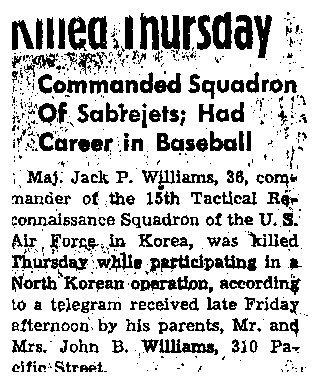
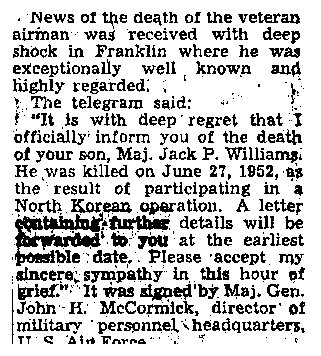
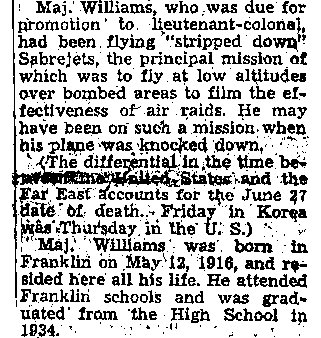
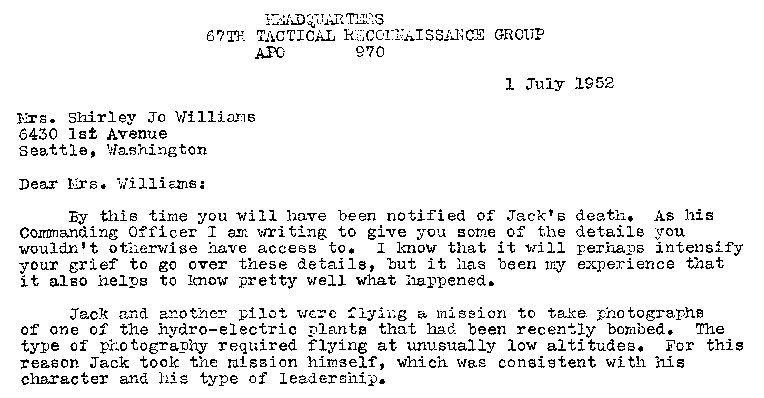




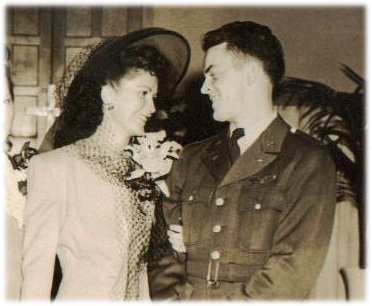
Shirley
and Jack Williams - Wedding Day
9/5/44 - Ft. Lawton, WA
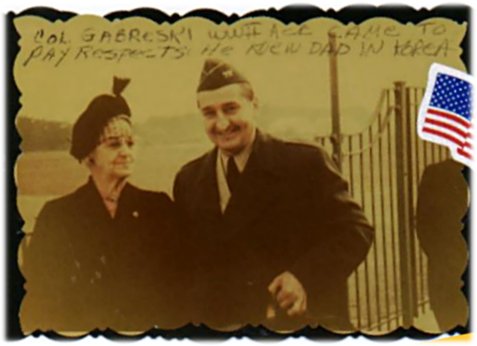
"Col.
Gabreski WWII Ace came to pay respects. He knew Dad in Korea."
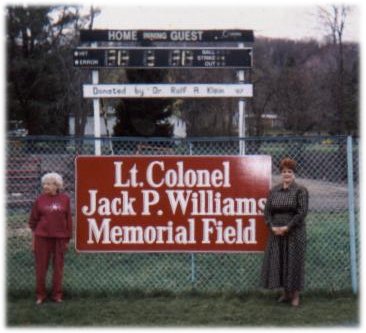
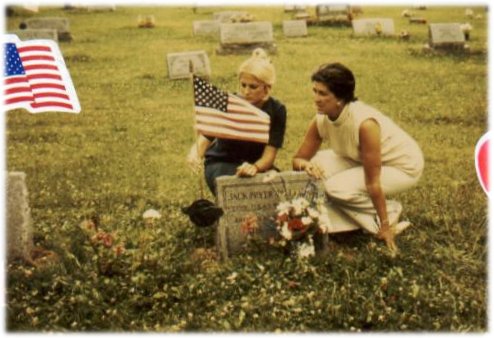
Kris and
Shirley Williams at Jack Williams' final resting place
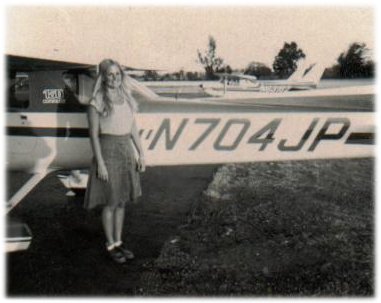
Kris Williams--like
her father--learned to fly...
"I
loved the 'JP' in the aircraft number of my plane. My father...was
sometimes called 'JP'. I always felt Dad was with me when I was flying."
****
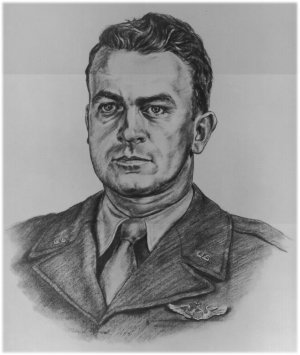
"Even
though Dad's time on earth was far too short, his footprint was very
large. He touched the lives of many individuals, who have never forgotten
his goodness and the extraordinary kind of man his was. Dad is my
standard in all that I do in life." -- Kris Williams, 2002
|
